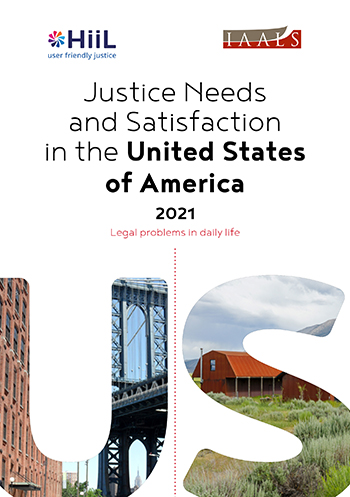US Justice Needs Data Reveals No Americans Unaffected by Justice Crisis
 It’s no secret that the United States is deeply embroiled in a justice crisis. According to the World Justice Project’s Rule of Law Index, the U.S. ranks 30th out of the world’s 37 high-income countries on the civil justice factor and 22nd on the criminal justice factor. Numerous studies have shone light on aspects of the crisis—some focusing on how it impacts low-income Americans, others homing in on the crisis’s effects in specific geographic regions. Now, with the new report from IAALS’ and HiiL’s joint US Justice Needs project, we have data from more than 10,000 surveyed individuals that illuminates the contours of the justice crisis in this country.
It’s no secret that the United States is deeply embroiled in a justice crisis. According to the World Justice Project’s Rule of Law Index, the U.S. ranks 30th out of the world’s 37 high-income countries on the civil justice factor and 22nd on the criminal justice factor. Numerous studies have shone light on aspects of the crisis—some focusing on how it impacts low-income Americans, others homing in on the crisis’s effects in specific geographic regions. Now, with the new report from IAALS’ and HiiL’s joint US Justice Needs project, we have data from more than 10,000 surveyed individuals that illuminates the contours of the justice crisis in this country.
What the Data Tells Us
The study shows that two-thirds (66%) of Americans experienced at least one justice issue in the past four years. The most common types of justice issues experienced are consumer issues, personal injury and personal property damage issues, issues with neighbors, work and unemployment issues, and crime. The data also demonstrates that, while certain groups are disproportionately impacted by justice issues, no socio-demographic group is untouched.
- Prevalence rates were largely the same across household income groups (64%–67%)
- Men experience legal issues at a slightly higher rate than women (67% vs. 64%)
- Minoritized groups experience legal issues at higher rates (66%–74%) than their white counterparts (64%)
- Younger adults experience legal issues most frequently, with the proportion decreasing as age rises (74% for the youngest group vs. 57% for the oldest group)
With respect to the perceived seriousness of these issues, the average score for reported issues was 5.88 on a scale of 1 (least serious) to 10 (most serious). The most serious types of legal issues were domestic violence and abuse (7.5), family (7), work and unemployment (7), and problems with the police (6.8). As with prevalence rates, there was considerable variation in the seriousness of legal problems experienced across demographic groups. Individuals in the following groups tended to experience more serious issues:
- Lower household income
- People of color
- Older age groups
About half (45%) of respondents reported experiencing negative consequences as a result of their most serious legal issue. Notably, though, the proportion of people who experienced negative consequences varied considerably by problem type. People with domestic violence issues (69%), employment issues (63%), problems with the police (58%), and family issues (58%) most frequently experienced negative consequences. The top five negative impacts most frequently experienced to a large or very large extent were:
- Negative emotions (55%)
- Negative impact on mental health (39%)
- Loss of money (37%)
- Negative impact on financial well-being (33%)
- Loss of time (32%)
A substantial majority—about three-quarters (74%)—reported taking some kind of action to resolve their most serious issue, though the proportion who took action varied across problem types. While a majority of people took action for all problem types, those with family issues (90%), public benefits issues (82%), land issues (81%), money-related issues (81%), and personal injury issues (80%) most frequently took action.
On average, people engaged 2.2 sources of help for resolving their most serious issue. There was, of course, considerable variation in the sources engaged for different types of problems; however, overall, the most commonly engaged sources of help were lawyers (23%), family members (21%), insurance companies (18%), police (18%), and friends (15%). Interestingly, the proportion of people who reported seeking help from the courts (14%) was relatively small. When we asked those who did not seek help from the courts their reasons for not doing so, the most frequently reported reasons were that the issue was minor (19%), perception that the issue was not a legal matter (17%), preference for a different path to resolution (14%), and believing that resolution was not worth the effort (9.3%).
We measured the quality of the process people experienced on seven dimensions: voice (the ability to tell one’s story), participation in decision making, objectivity, correctability of the decision, respect, process clarity, and trustworthiness. Respondents assessed each of these items on a five-point scale, with 1 connoting low quality and 5 connoting high quality. The sources of help that most frequently received high marks for process quality were mental health professionals, medical professionals, and lawyers. The sources of help that most often were among those rated as having the lowest quality were federal agencies/organizations, employers, and courts. The three sources of help considered highest and lowest quality for each of the seven dimensions of process quality are shared below.
Voice
| Highest quality | Lowest quality |
|---|---|
| Mental health professional (4.3) | Employer (3.6) |
| Medical professional (4.2) | Federal agency/organization (3.4) |
| Lawyer (4.9) | Court system (3.3) |
Participation in Decision Making
| Highest quality | Lowest quality |
|---|---|
| Medical professional (3.7) | Insurance company (2.9) |
| Mental health professional (3.7) | Employer (2.2) |
| Lawyer (3.3) | Federal agency/organization (2.6) |
Objectivity
| Highest quality | Lowest quality |
|---|---|
| Mental health profession (4.0) | Court system (3.4) |
| Medical professional (4.0) | Federal agency/organization (3.3) |
| Lawyer (3.9) | Employer (2.9) |
Correctability of Decision
| Highest quality | Lowest quality |
|---|---|
| Medical professional (3.4) | Financial institution (2.9) |
| Mental health professional (3.2) | Police (2.8) |
| Lawyer (3.0) | Federal agency/organization (2.8) |
Respect
| Highest quality | Lowest quality |
|---|---|
| Mental health professional (4.4) | Federal agency/organization (3.6) |
| Medical professional (4.3) | Court system (3.6) |
| Lawyer (4.2) | Employer (3.4) |
Process clarity
| Highest quality | Lowest quality |
|---|---|
| Financial institution (4.4) | Local agency/government (3.4) |
| Lawyer (4.0) | Federal agency/organization (3.4) |
| Medical professional (3.9) | Employer (3.0) |
Trustworthiness
| Highest quality | Lowest quality |
|---|---|
| Mental health professional (4.1) | Court system (3.3) |
| Medical professional (4.1) | Federal agency/organization (3.2) |
| Financial institution (3.9) | Employer (2.9) |
In addition to asking about sources of help, we asked respondents specifically about the resources they went to for legal information and advice. Overall, just under two-thirds (62%) reported seeking legal information or advice in resolving their most serious issue. A majority of people (55%) engaged only one source of legal information and advice, 20% engaged two sources, and the remaining quarter (24%) engaged three or more sources. The most frequently used sources of legal information and advice were:
- Internet (31%)
- Lawyer (29%)
- Family member (25%)
- Friend (20%)
- Police (13%)
We asked people who reported not going to a lawyer for legal information and advice their reasons; the most frequent responses were that a lawyer was not necessary (26%), a belief that the issue was not a legal issue (17%), that the issue was not appropriate for a lawyer (16%), and that the person could not afford a lawyer (14%).
We were also interested to know what people viewed as the three most valuable characteristics of legal information and advice for resolving an issue like theirs. The characteristics valued most were trustworthiness (46%), easy to understand (39%), targeted to the individual’s situation (31%), and comes from a professional (31%); the characteristics valued the least were provided quickly (20%), provided one-on-one help from a person (17%), and available online or via app (7%).
Where We Go from Here
Our report provides a great many key insights into the state of justice in the United States. It points to a justice crisis that is pervasive, impacts everyone—but is not equally distributed—and can result in severe negative consequences in people’s lives. It also directs us to critical actions we can take to achieve user-friendly justice. But there’s still so much we can explore in our data. Perhaps most importantly, we can further disaggregate the data to gain a deeper understanding of how experiences differ across groups. The insights we glean from this research can be used as a cornerstone of evidence-based justice reform and innovation in our country.



